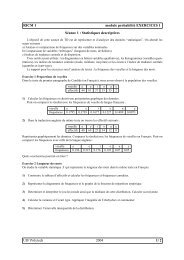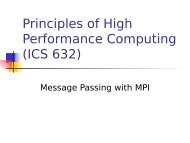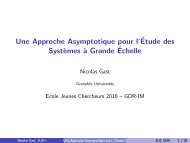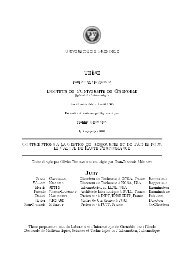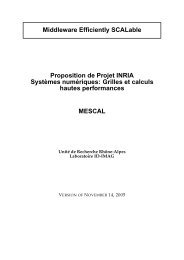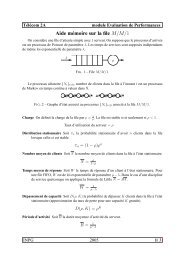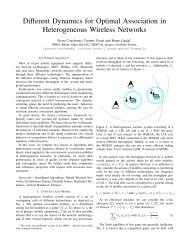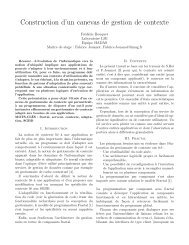Distributing labels on infinite trees
Distributing labels on infinite trees
Distributing labels on infinite trees
You also want an ePaper? Increase the reach of your titles
YUMPU automatically turns print PDFs into web optimized ePapers that Google loves.
Proof. If P is reducible, P can be decomposed into⎡⎤⎡Q K 1 · · · K m0 P 1 · · · 0P = ⎢⎣.. . . . ..⎥. ⎦ and P n = ⎢⎣0 0 . . . P mQ n K 1 ′ · · · K m′0 P1 n · · · 0.. . . . .. .0 0 . . . Pmn⎤⎥⎦C<strong>on</strong>sidering all the paths in G(T ) of length n, starting in the root, the number of pathsending in comp<strong>on</strong>ent S l is N l (n) = d n ∑ i∈S lP1i n. Let us decompose all the paths ending in S linto two sub-paths: <strong>on</strong>e (of length k) before entering S l and <strong>on</strong>e (of length n − k) inside S l , weget from the decompositi<strong>on</strong> of P n , N l (n) = d n ∑ nk=0 (1, 0, . . . , 0)Qk K l u l , where u l is a vectorwhose coordinates are 1 in S l and 0 everywhere else.The number of 1 in the rooted subtree of T of size 2n is the number of <strong>on</strong>es in all the pathsof length n plus the number of <strong>on</strong>es in the sub<strong>trees</strong> of size 1. When n is large, the number of<strong>on</strong>es in the paths can be neglected with respect to the number of <strong>on</strong>es in the end <strong>trees</strong>.Finally, the number of <strong>on</strong>e in a tree of size 2n is the number of <strong>on</strong>es in each possible end-treeof size n times the number of such <strong>trees</strong>, namely N l (n). When n goes to infinity, the density of<strong>on</strong>es goes to ∑ l=1..m α l(1, 0, . . . , 0)(I − Q) −1 K l u l = (α 1 · · · α m )R t , with R l = (1, 0, . . . , 0)(I −Q) −1 K l u l .An example illustrating the computati<strong>on</strong> of the rooted average density of a tree is given inFigure 5. The graph G(T ) has two final comp<strong>on</strong>ents, <strong>on</strong>e aperiodic comp<strong>on</strong>ent with density 1 andanother <strong>on</strong>e with period 2 with average density 1/2. Starting from the root, both comp<strong>on</strong>entsare reached with probability 1/2. Therefore, such a tree has an average rooted density α =1/2(1/2) + 1/2(1) = 2/3.Also, it is not difficult to show that if all final comp<strong>on</strong>ent have a density (rather than anaverage density), then the tree has a rooted density, given by the same formula as in Theorem3.3.Finally, it is fairly straightforward to prove that since the K · K kernel P of the Markov chainassociated with G(T ) has all its elements of the form a/d, then the stati<strong>on</strong>ary probabilities π aswell as the average rooted density α of a rati<strong>on</strong>al tree are rati<strong>on</strong>al numbers of the form c/b with0 ≤ c ≤ b ≤ d K+1 . This fact will be used in the algorithmic secti<strong>on</strong> 5 to make sure that thecomplexity of the algorithms does not depend <strong>on</strong> the size of the numbers.4 Balanced and Mechanical TreesIn this secti<strong>on</strong>, we will introduce our most important definiti<strong>on</strong>s: str<strong>on</strong>gly balanced and mechanical<strong>trees</strong> and explore the relati<strong>on</strong>s between them. In particular we will prove that in the caseof irrati<strong>on</strong>al <strong>trees</strong> they represent the same set of <strong>trees</strong>, giving us a c<strong>on</strong>structive representati<strong>on</strong> ofthis class of <strong>trees</strong>. These results are very similar to the <strong>on</strong>es <strong>on</strong> words, which are summarizedbelow.4.1 Sturmian, Balanced and Mechanical WordsOne definiti<strong>on</strong> of a Sturmian word uses the complexity of a word. The complexity of an <strong>infinite</strong>word w is a functi<strong>on</strong> P w : N → N where P w (n) is the number of distinct factors of length n of theword w. A word is periodic if there exists n such that P w (n) ≤ n. Sturmian words are aperiodicwords with minimal complexity, i.e such that for any n:P w (n) = n + 1. (1)10





